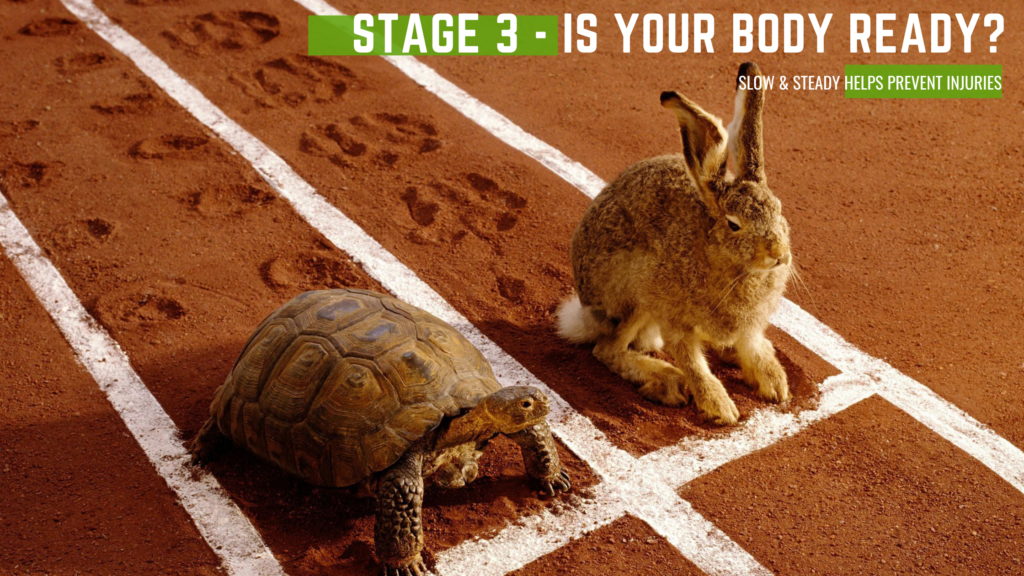
Dr. Mitch Broser
Is your body ready for Stage 3?
Here in Toronto, we are all expecting the re-opening of gyms and fitness facilities very soon. After several months at home and away from our regular fitness routine, we have been forced to either sink or swim – stop our fitness routine or adapt our fitness routine. For many, there has been no accessibility to equipment like heavy weights and fancy machines. With the re-opening of gyms looming, you may be excited to get back and push heavy weight, crush the next WOD, or start where you left off in chasing that health or fitness goal you had pre-COVID. We’re excited too, but before we do that, I need to remind you:
“You are not the person you were 4 months ago.”
All of those gains you made before the gym closures were a result of your consistent hard work. As you train your body in a specific way, your body adapts specifically to do that training better. When you get away from that consistent work, your body adapts. Think about this – Have you seen the Netflix Docu-Series “The Last Dance”? How about ‘Space Jam?” Anyways, In October 1993, Michael Jordan left basketball for a stint in the MLB. In March 1995 (17 months later), Jordan returned to the NBA. In his first game back, he scored 19 points. Not too bad, but in the 9 seasons leading up to his sudden departure, he averaged 31.5 points per game. Now, four games later he did score 55 points, but that is beside the point. The point is that after significant time off, even the legend Michael Jordan saw a loss in performance. That wasn’t because he was out of shape -in his 17 months off from basketball, he was training very hard and was in incredible shape, but he was in shape for baseball. Maintaining his level of fitness and athleticism was not enough to maintain his performance and dominance in basketball.
The same thing occurs when you take some time off of a type of training or sport. As I am sure you have experienced at some point, starting to train for the first time or getting back into training after a long time off can be very challenging and frustrating. The training sucks and you are left sore for days. Even if you have been maintaining your fitness, doing something your body is not used to can be hard on the body. I went to the park a few weeks back and threw a football around with Sylvie for a bit. I haven’t done that in years! It didn’t take long before my arm fatigued, and my shoulder was sore the next day.
This all ties in to load management and specificity of loading. More simply – frequency and intensity of an exercise or activity and specifically what that exercise or activity is. In the literature, they refer to chronic and acute workload. Chronic workload refers to the amount of training you have done in the past (in the preceding past 4-8 weeks). It is an indication of how much training your body is used to and is able to handle. Acute workload refers to the amount of training you have done in the past week. The research shows that the higher your chronic workload (the more well-adapted and resilient you are), the lower the risk of injury. Dramatic changes in your acute workload can have significant effects (very low acute workload will lead to detraining, or fitness/health regression, or reduced resilience). Very high acute workload can increase your risk of injury (you are pushing yourself past your capacity or fitness/health level). To learn more about workload management, injury prevention and performance enhancement, check out one of my previous blogs ‘Workload: Injury & Performance’.
Like I touched on before, specificity is something you must also consider. Your body is well adapted to the training you did, or didn’t do, for the past 4 months. If you haven’t pushed heavy weights, done complex lifts or attended your favourite spin class since pre-pandemic days, then your body’s chronic workload is low and your capacity is reduced. If you try to return to the gym and try doing the same workouts as you did the last time you were there, that is a huge spike in your acute workload. This huge spike can put you at greater risk of injury.
When we go back to the gyms, let’s keep in mind that we are not the same person we were 4 months ago. We need to regress before we progress. Regress the intensity, frequency and complexity. Lay down the next brick when your body is ready for the next one. Work on the prerequisites for the training or activity you want to do. Work on cardiovascular capacity, work on joint health and function. Control your own body before you control other weights, objects or implements. You should always be working on the foundation and building from the bottom up. Sometimes, you have to rebuild. You can’t put the roof up before you build the walls.

